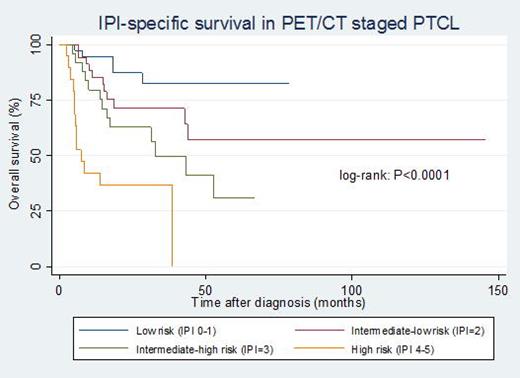Abstract
PET/CT has proven to be highly accurate for staging of Hodgkin lymphoma. A recent study also reported that PET/CT detected additional disease sites in 50% of patients with peripheral T-cell lymphoma (PTCL) as compared to conventional CT-based staging and had higher sensitivity for extranodal disease. This may challenge the validity of pre-therapeutic prognostic tools such as the widely used international prognostic index (IPI), which contains imaging-depended clinical features such as Ann Arbor stage and extranodal disease.
To examine the validity of IPI in PET/CT staged PTCL patients treated with CHOP or CHOP-like first line therapies.
The present retrospective study included PTCL patients from five Danish referral hematology centers. Potential candidates for the study were identified from a search in the Danish Lymphoma Registry (LYFO). Patients with PTCL not otherwise specified (PTCL NOS), anaplastic large cell lymphoma (ALCL), or angioimmunoblastic T-cell lymphoma (AITL) were included if they underwent PET/CT staging and were treated with CHOP or CHOP-like first-line therapy +/- consolidating high-dose therapy. Medical records were retrieved and reviewed for all included patients.
During the time period 2006-2013 a total of 137 out of 259 PTCL patients were staged with PET/CT. Of these 119 (87%) received CHOP or CHOP-lile first-line therapy and were included in this analysis. The patients were diagnosed with PTCL NOS (n=49), AITL (n=18), and ALCL (n=52). The median age was 58 yrs. and the male:female ratio was 1.3. Advanced stage disease (III-IV) was diagnosed in 71% (n=85) and 27% (n=32) of the patients had more than one extranodal site involved. In univariate Cox regression analyses elevated LDH (HR 2.77, 95%CI 1.44-5.34), > 1 extranodal disease site (HR 3.09, 95%CI 1.67-5.72), age > 60 yrs. (HR 2.49, 95%CI 1.35-4.59), ECOG performance > 1 (HR 2.03, 95% CI 1.08-3.83), and Ann Arbor stage III-IV (HR 2.43 95%CI 1.08-5.73) were all significantly associated with inferior overall survival (OS). The presence of more than one extranodal disease site was an adverse prognostic factor for both age groups. In a multivariate Cox regression analysis including these variables, age > 60 yrs., > 1 extranodal site, and elevated LDH retained independent association with short OS. Using IPI score 0-1 (low-risk) as reference group score the HRs for death were 2.49 (95%CI 0.87-7.19) for low-intermediate, 4.31 (95%CI 1.53-12.09) for high-intermediate, and 12.74 (95%CI 4.43-36.61) for high risk patients. IPI-specific OS fractions are show in the figure.
Despite the potential stage migration associated with the introduction of new and more accurate imaging modalities such as PET/CT, the original IPI developed two decades ago continues to be a highly valid tool for predicting overall survival in PTCL patients treated with CHOP or CHOP-like first-line therapies.
TCEG, MBP, and LCG contributed equally to the present work.
No relevant conflicts of interest to declare.
Author notes
Asterisk with author names denotes non-ASH members.


This feature is available to Subscribers Only
Sign In or Create an Account Close Modal